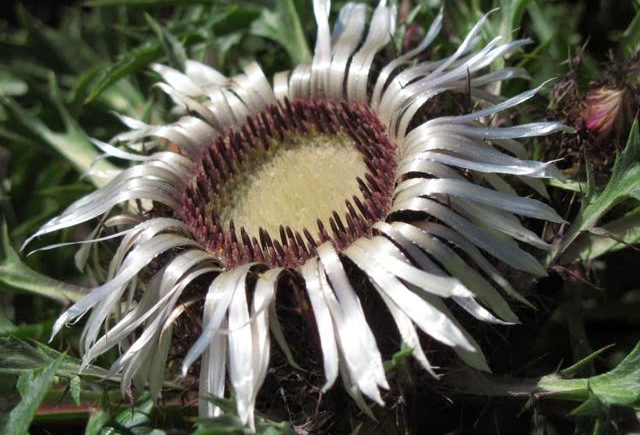| Why, it’s silver thistle (Carlina acaulis). Here’s how I found out. Wish my photo gave you a better idea of its metallic sheen. |
Don’t know about you, but when it comes to knowing how to identify unknown plants (or bugs or plant diseases or…), I love to play detective. I photograph a lot of plants, and also try to shoot their labels or tags. But sometimes there is no tag – or it’s unclear which tag belongs where. To paraphrase Anne Bancroft in The Miracle Worker, you need to know what it is in order to know what it is. Here’s roughly how I went about putting a name to the pretty face above.
Image Search can speed up ID
What did we do before the internet? When trying to ID anything now, my go-tool is image search. It’s a shortcut to page content, with many, many images on a scroll, quickly revealing whether your search terms are relevant. Don’t be afraid to “load more” at the bottom of a scroll. You can also use the “Search Tools” at the top of your results page to narrow your results by colour. [Update: Avoid Pinterest links when you use image search, and there are many these days. But they can be a black hole that leads nowhere when you’re looking for identification.]
Look for family relationships
Because plant families have family resemblances, they might give me an ID, or simply clues. The mint family, for instance, all have square stems, and the mustard clan all bear flowers with four petals in a cross shape – the reason they are sometimes called crucifers. You’re lucky if you notice either.
Flowers are what taxonomists use to classify plant families. It’s hard to identify a plant that’s not in flower or fruit. So I began with the “petals” on this cool plant. They reminded me of strawflowers. Perhaps they were related. Hence my search: strawflower silver. Hmmm. Close, but no cigar.
Search for a distinctive feature… or features
The petals were distinctive, but so was the flower centre. So I tried: flower tufted disk silvery sepals – which was a definite no – then: flower tufted disk silvery rays. Nope.
Simplify the search terms
Perhaps I was getting too complicated with specific words like tufted, disk and rays? So I simplified to: silver flower sepals Oh dear, that was way too simple and ambiguous. That’s probably because of the word silver, which applies to many different subjects. Typically, simplifying your search can remove distractions, so don’t rule out this step because it didn’t work for me this time.
Step back and try something else. Repeat.
If the “petals” and “disk” were getting me nowhere, what about the leaves? They reminded me of thistles. How about: thistle with silvery bracts
Lo and behold, in the top row, there was my flower: The silver thistle, Carlina acaulis. One link gave me a good look at the flower; another even told me I could buy seeds from Richter’s – who give the medicinal properties of this plant in their online seed catalog. Interesting.
Look close, closer, closely
Finally, when using image search for plant ID, it’s important to look closely at the image. Compare it point by point to your original. This might seem to go without saying, but I’m often surprised how many would-be helpful detectives offer their IDs based on what can only be a cursory look.
That said, it’s equally smart to look at the source of the info found. A university or botanical garden, for example, may be more reliable than a blogger (like me) or even an online supplier. Find at least a couple of links to confirm your ID. And happy hunting.
What tricks can you share for your own detective work? I’d love to hear them.





4 comments
Excellent post full of good tips!
Thanks, Alison. I hope it helps you find what you're looking for.
Excellent research lesson. Thanks.
Pat, you're most welcome.